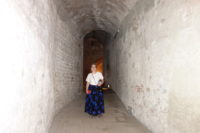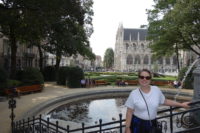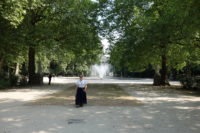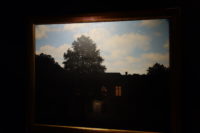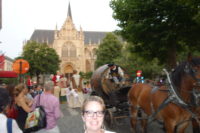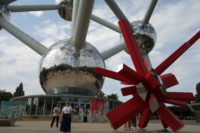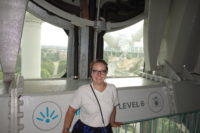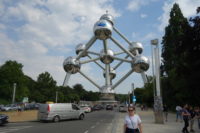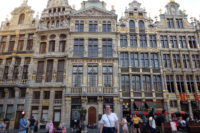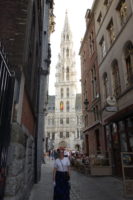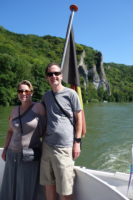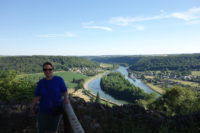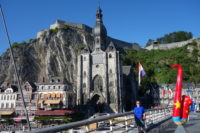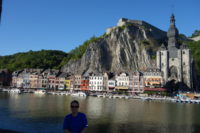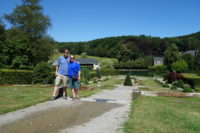 When Mer announced five years ago that she wanted to go to each of the European countries covered by tour guide Rick Steves, she left the yearly picking of each country up to me. So I picked Belgium this year, and I don’t remember the specifics as to why. I think I wanted a small country for less driving. Check. I wanted a flat country, since we have spent the last five summers in hilly or mountainous country. Flat – check. I wanted somewhere cool, because I do not feel well when it is really hot (above eighty, and especially above eighty-five). The normal temperatures of Belgium this time of year are in the mid-to-high sixties, so that is perfect. Except we have had unusually hot temperatures on this vacation, several times reaching eighty-three or eighty-four degrees. The hot weather has also brought tons of sun, so we have had no rain in a region where it usually rains half the days. So that has been a solid trade-off, but it has meant managing our touring to keep me from getting sick from the heat.
When Mer announced five years ago that she wanted to go to each of the European countries covered by tour guide Rick Steves, she left the yearly picking of each country up to me. So I picked Belgium this year, and I don’t remember the specifics as to why. I think I wanted a small country for less driving. Check. I wanted a flat country, since we have spent the last five summers in hilly or mountainous country. Flat – check. I wanted somewhere cool, because I do not feel well when it is really hot (above eighty, and especially above eighty-five). The normal temperatures of Belgium this time of year are in the mid-to-high sixties, so that is perfect. Except we have had unusually hot temperatures on this vacation, several times reaching eighty-three or eighty-four degrees. The hot weather has also brought tons of sun, so we have had no rain in a region where it usually rains half the days. So that has been a solid trade-off, but it has meant managing our touring to keep me from getting sick from the heat.
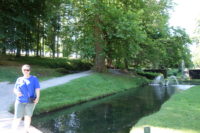
So we started this morning off driving to the nearby Jardins d’Annevoie (the gardens of Annevoie). It was still cool at 10:00 when we got there, and Mer was not sure what we were doing when I pulled into the parking lot. It was a gravel lot looking up at a small farmhouse. She was wondering why we would drive to see a farmhouse; however, the gardens were across the street, and she was okay once she got a glimpse of them.
In the interest of getting going in the morning, I had us skip breakfast, knowing we were going to a tourist attraction that should have a cafe. They did, and I was thrilled we had waited. We had breakfast on our private balcony (no one else was there yet), looking out over one corner of the gardens. It was delightful.
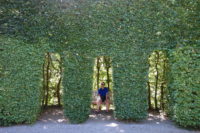
When I say “gardens,” you need to picture manicured grounds and not just flowers. The gardens date from about 1760, and shrubs and fountains and paths were valued. There were some flowers, but what brought me to these gardens were the descriptions of the water features. The gardens have water everywhere, and it is all gravity-fed, so the fountains and brooks have been flowing continuously for 250 years.
The results are spectacular. I love water, and so this is hands-down my favorite garden anywhere, and that includes Versailles. Fountains fed pools which fed other fountains which fed streams, all in a park-like setting with trees (some 250 years old) and hedges and arbors and nooks and statues. It was largely shaded, so the sun was not an issue. They had multiple swans, including a black one, and we kept hearing a peacock, although we never saw it. We walked around the grounds for two hours, and we were pretty much by ourselves. We saw six other people, but four of them were as we were leaving, and the other two were so far ahead of us we only saw them twice, at a distance. It was right out of a Jane Austen novel, from which I quoted freely in order to impress my beloved (it is important to stress to ladies of certain breeding the importance of learning and discourse). I enjoyed Ghent and Bruges, but this was very different, and the peace of the gardens was quite welcome.
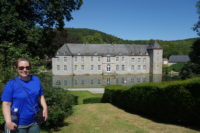 We headed back to the hotel room for a cheap take-out lunch in our little kitchen overlooking the Meuse. That made me sleepy, so we hid from the afternoon sun for forty-five minutes while resting in our room. It was still hot out when we left around 3:00, so there was only one thing for it to escape the heat – go underground.
We headed back to the hotel room for a cheap take-out lunch in our little kitchen overlooking the Meuse. That made me sleepy, so we hid from the afternoon sun for forty-five minutes while resting in our room. It was still hot out when we left around 3:00, so there was only one thing for it to escape the heat – go underground.
Two summers ago, when we were in Austria, we were having unusually hot weather then as well. Mer took me on a tour of a salt mine, and it was one of the most wonderfully cool (both senses of the word) moments I had in Austria. It made quite an impression. So, when researching things to do in this area, when I saw we could go to a cave, I remembered Austria. It is a great way to get out of the heat. When I considered that I was, for the time being, castled and museumed out, and saw it was a hot day, we were going caving.
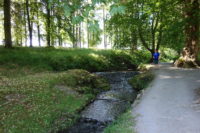 The Grottes de Han (the Caves of Han) are in the town of Han, about thirty minutes from Dinant. I expected to pull up to a parking lot in front of a cave. Instead, we came to the center of Han, which is not big, but is not just a crossroads. It seems the cave had been a tourist attraction for over two hundred years. After finding parking a couple of blocks away, we walked back to the center, where we could buy tickets for the cave, the safari park, or both. We then waited twenty minutes for our train to take us to the cave entrance, about a mile-and-a-half away. It is possible that the train may have been in use for two hundred years as well; it was rickety and loud, and it was a ton of fun. It ran us along the local river (the Lesse), past a small campground, and through some forested hills.
The Grottes de Han (the Caves of Han) are in the town of Han, about thirty minutes from Dinant. I expected to pull up to a parking lot in front of a cave. Instead, we came to the center of Han, which is not big, but is not just a crossroads. It seems the cave had been a tourist attraction for over two hundred years. After finding parking a couple of blocks away, we walked back to the center, where we could buy tickets for the cave, the safari park, or both. We then waited twenty minutes for our train to take us to the cave entrance, about a mile-and-a-half away. It is possible that the train may have been in use for two hundred years as well; it was rickety and loud, and it was a ton of fun. It ran us along the local river (the Lesse), past a small campground, and through some forested hills.
We had a fairly small group of about dozen people, and we circled around the guide. Who spoke French. And then moved on. Seemed as if I was going to be a bit clueless on the information of the cave. Mer translated what she could for me, but the cave acoustics were prone to echoes, and the guide spoke quickly, so Mer did not always catch much. But that was all right: we were headed underground, where we would need light jackets, and it was going to be full of rock formations, and an unexpected-to-me underground river, happily called the Styx.
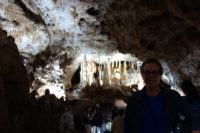 The cave is unusual in that it is a fairly horizontal cave, with little vertical change. There is a hill on top of the cave, so the cave gets deeper while staying fairly level. Part of the river had run through the cave at one point, and parts of it still flood from time to time. It is made of of several huge chambers connected by small passageways. There were limestone columns that were twenty or thirty feet high, and gentle and delicate lace-like formations of deposited limestone, twisting back and around on itself like fabric.
The cave is unusual in that it is a fairly horizontal cave, with little vertical change. There is a hill on top of the cave, so the cave gets deeper while staying fairly level. Part of the river had run through the cave at one point, and parts of it still flood from time to time. It is made of of several huge chambers connected by small passageways. There were limestone columns that were twenty or thirty feet high, and gentle and delicate lace-like formations of deposited limestone, twisting back and around on itself like fabric.
We crossed the river several times, and it was fascinating to see the water flowing with vapor coming off the surface. The entire cave was well lit with LED lights, and the guide would turn them on and off to highlight certain parts of the chambers we were in. The lights off the water were lovely.
In one large chamber we entered, they had small cave-drawings of animals projected on the walls, with projected fires burning in front of them. I saw the projectors, and they were large and high-end, so I was curious about that, since a smaller and much cheaper projector could have done the same thing. Then the guide had us sit down on chairs, and she turned down the lights, and the entire front half of the cave became a huge screen, with laser light show included. It was a stylized computer-generated film of the cave, from the Big Bang to the present day, somehow all tied to a stag running around. It was really impressive, and explained the need for the projectors. I don’t think it had much of anything to do with the cave, but it was really entertaining.
In the largest cavern, the guide took us about halfway up to a landing, and then sang two notes. Way at the top of the cavern, a torch appeared, and it was run by a teenager down to us. Because I do not speak French, it was not clear to me if that is where early explorers came in, or what was the origin of the torchbearer; it seemed it was a tradition that until 1989 was still done with a real torch. They stopped that because of the smoke pollution in the cave. It is now done by a fairly-effective LED torch instead.
The tour finished with a long stretch of elevated walkway along one of the underground streams, and took us out into daylight. We were a five-minute walk from town and our car, so we headed home for supper in our kitchen.
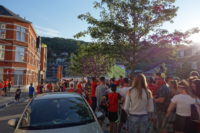 Since today was the Belgium-Japan World Cup game, and it was an elimination game, we walked down after dinner to a small town square where the town had a large screen set up for the game. The square was jammed with people, and included a for-locals Belgian waffle stand. We watched about twenty minutes of the game, and Belgium was clearly dominating, but could not score. We went back to the room and could tell by noise levels what was going on. Japan scored two quick goals in the second half to go up 2-0, and Belgium finally tied things up in the last fifteen minutes. Then, four minutes into bonus/injury time, Belgium scored and the place went nuts. Then, two minutes later, the game ended, and the place went really crazy. It is kind of fun to be in a World Cup country, assuming I can get any sleep tonight.
Since today was the Belgium-Japan World Cup game, and it was an elimination game, we walked down after dinner to a small town square where the town had a large screen set up for the game. The square was jammed with people, and included a for-locals Belgian waffle stand. We watched about twenty minutes of the game, and Belgium was clearly dominating, but could not score. We went back to the room and could tell by noise levels what was going on. Japan scored two quick goals in the second half to go up 2-0, and Belgium finally tied things up in the last fifteen minutes. Then, four minutes into bonus/injury time, Belgium scored and the place went nuts. Then, two minutes later, the game ended, and the place went really crazy. It is kind of fun to be in a World Cup country, assuming I can get any sleep tonight.
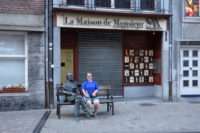 So, here it is, about 10:30 pm, and the evening is cool again. Based on the honking horns and cheering people, they are pretty happy that the heat of the day is over too. Tomorrow, on to Brussels. I’ve loved Dinant – I could have spent another day here easily, and maybe even two more. It is a lovely part of Belgium. Our guide in Ghent had found out we were going to Dinant, and she asked me what we were going to do after the first hour and a half. And here I never even managed to get up to the citadel in town. Next time.
So, here it is, about 10:30 pm, and the evening is cool again. Based on the honking horns and cheering people, they are pretty happy that the heat of the day is over too. Tomorrow, on to Brussels. I’ve loved Dinant – I could have spent another day here easily, and maybe even two more. It is a lovely part of Belgium. Our guide in Ghent had found out we were going to Dinant, and she asked me what we were going to do after the first hour and a half. And here I never even managed to get up to the citadel in town. Next time.
PS – I forgot to mention – when we left the hotel this morning, we saw a guy walking along with a backpack. That was not unusual, but what was amazing was the black cat sitting on top of his backpack, just riding along. It was really cute.
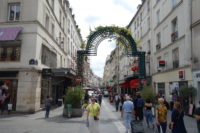 And so, all good things must come to an end. We fly out tomorrow, Paris to Toronto, and, God willing, will be sleeping in our own beds by 10:00 or 11:00 tomorrow night. We did not want to risk train breakdown, train strikes, etc., so we came into Paris today after a leisurely morning in our Brussels hotel. We got into our Paris B and B a little before 4:00, and so that left us with a little time for sightseeing and exploring.
And so, all good things must come to an end. We fly out tomorrow, Paris to Toronto, and, God willing, will be sleeping in our own beds by 10:00 or 11:00 tomorrow night. We did not want to risk train breakdown, train strikes, etc., so we came into Paris today after a leisurely morning in our Brussels hotel. We got into our Paris B and B a little before 4:00, and so that left us with a little time for sightseeing and exploring.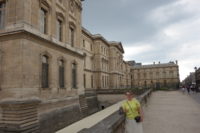
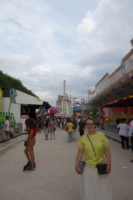
 It has been a great little trip. I look forward to these times away with Meredith – it breaks up the routine of bills, chores, and grading. Two weeks together is wonderful, though I am looking forward to some routine now, especially one involving petting kitties at home. We saw several Belgian cats, but they were too wary to come close enough for to us to pet them, so we are both going through withdrawal. It will be great to see the people back home, once the jet lag wears off (I’m usually fine by day three, which will be Monday). It is amazing to live in an age where you can go from Paris to Cuyahoga Falls in about twenty-one hours, and I am grateful that Mer pushes for our going on these trips. Every time, they keep us wanting to come back for more.
It has been a great little trip. I look forward to these times away with Meredith – it breaks up the routine of bills, chores, and grading. Two weeks together is wonderful, though I am looking forward to some routine now, especially one involving petting kitties at home. We saw several Belgian cats, but they were too wary to come close enough for to us to pet them, so we are both going through withdrawal. It will be great to see the people back home, once the jet lag wears off (I’m usually fine by day three, which will be Monday). It is amazing to live in an age where you can go from Paris to Cuyahoga Falls in about twenty-one hours, and I am grateful that Mer pushes for our going on these trips. Every time, they keep us wanting to come back for more.
